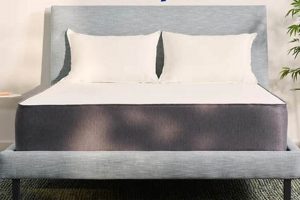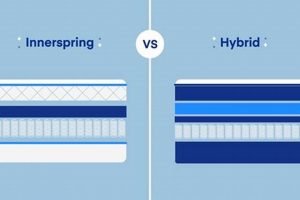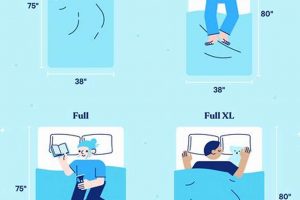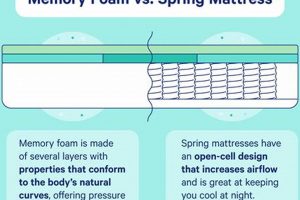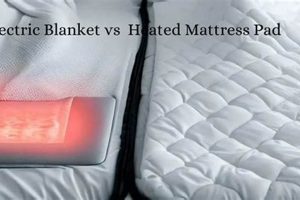The selection of a sleeping surface involves navigating a range of materials and construction methods, each presenting distinct characteristics. Two prevalent options include those incorporating visco-elastic foam and those utilizing coiled metal support systems. The former conforms closely to the sleeper’s body, distributing weight and minimizing pressure points. The latter provides a more resilient and buoyant feel, often associated with enhanced support and airflow.
The importance of choosing an appropriate sleeping surface extends to overall well-being. A supportive and comfortable surface can contribute to improved sleep quality, potentially alleviating aches and pains. Historically, coiled metal designs have been a mainstay in bedding. However, advances in material science have led to the increased adoption of conforming foam technologies. Both represent significant investments in long-term health and comfort.
A comparative analysis of these two distinct mattress types reveals key differences in factors such as pressure relief, support, temperature regulation, motion isolation, and durability. Understanding these differences is crucial for making an informed decision based on individual needs and preferences. The following sections will delve into these aspects in detail.
Selecting the Optimal Sleeping Surface
Choosing between different mattress constructions requires careful consideration of individual needs and preferences. Understanding the nuances of each type can lead to a more restful and supportive sleep experience.
Tip 1: Prioritize Pressure Relief. Individuals with joint pain or pressure sensitivities may benefit from surfaces that conform closely to the body, distributing weight evenly. This reduces concentrated pressure points, potentially alleviating discomfort.
Tip 2: Evaluate Support Needs. Consider body weight and sleeping position. Heavier individuals or those who sleep on their stomach may require a firmer, more supportive surface to maintain proper spinal alignment.
Tip 3: Assess Temperature Sensitivity. Some materials retain heat more than others. Individuals prone to overheating during sleep should opt for options with enhanced airflow and cooling technologies.
Tip 4: Consider Motion Isolation. If sharing a bed, motion isolation is crucial. Surfaces that absorb movement can minimize disturbances caused by a partner’s tossing and turning.
Tip 5: Evaluate Durability. Consider the long-term value and potential lifespan. Higher-density materials and quality construction contribute to enhanced durability and resistance to sagging or deformation.
Tip 6: Understand Edge Support. Strong edge support prevents roll-off and provides a stable surface for sitting on the edge of the bed. This is particularly important for individuals with mobility issues.
Tip 7: Research Material Composition. Be aware of the materials used in the mattress construction, including certifications for safety and low emissions. This ensures a healthier sleep environment.
By carefully evaluating these factors, an informed decision can be made, leading to improved sleep quality and overall well-being.
The subsequent sections of this article will explore specific features and benefits, providing a comprehensive guide to selecting the most suitable option.
1. Pressure Relief
Pressure relief is a crucial factor in mattress selection, directly impacting sleep quality and physical comfort. The extent to which a mattress can alleviate pressure points influences blood circulation, reduces tossing and turning, and minimizes aches and pains. Understanding how different mattress types address pressure relief is paramount.
- Conformity to Body Contours
Visco-elastic foam excels in conforming to the body’s unique shape, distributing weight evenly across the surface. This reduces concentrated pressure on areas like the shoulders, hips, and knees. Conversely, coiled metal designs offer more generalized support, potentially creating localized pressure points, particularly for side sleepers.
- Material Density and Responsiveness
The density and responsiveness of the mattress material significantly affect pressure relief. Higher-density foam provides greater support and resistance to compression, maintaining proper spinal alignment. Responsive materials quickly adapt to changes in pressure, preventing the build-up of discomfort. In contrast, spring mattresses often rely on padding layers for initial comfort, which may compress over time, diminishing pressure relief.
- Impact on Circulation
Excessive pressure on certain areas can restrict blood flow, leading to discomfort and potential nerve compression. Surfaces that effectively distribute weight promote healthy circulation, preventing numbness and tingling. Foam’s contouring ability generally facilitates better circulation compared to spring mattresses, which may create more localized pressure.
- Influence on Spinal Alignment
Maintaining proper spinal alignment is essential for preventing back pain and promoting restful sleep. Mattresses that adequately support the body’s natural curves help maintain alignment, minimizing stress on the spine. Foam mattresses are often recommended for their ability to adapt to the spine’s curvature, while spring mattresses require careful consideration of coil gauge and support layers to ensure adequate alignment.
In conclusion, the ability of a mattress to effectively alleviate pressure points is a critical determinant of sleep quality and overall comfort. Visco-elastic foam’s contouring properties generally provide superior pressure relief compared to traditional spring mattresses, although advancements in spring mattress technology are continually aimed at enhancing this aspect. Individual preferences and specific physical needs should guide the selection process.
2. Support Systems
The internal structure and construction of a mattress, referred to as the support system, dictates its ability to maintain spinal alignment, distribute weight, and provide overall stability. The design and materials employed in the support system significantly differentiate foam and spring mattresses, influencing their performance characteristics and suitability for various sleep preferences.
- Coil Configuration (Spring Mattresses)
Spring mattresses utilize various coil configurations, including Bonnell coils, offset coils, continuous coils, and pocketed coils. Bonnell coils, an older design, are interconnected, providing a uniform but potentially less contouring support. Pocketed coils, individually wrapped in fabric, offer more independent support, reducing motion transfer. Coil gauge (wire thickness) influences firmness and support, with lower gauges indicating firmer support. The arrangement and gauge of coils directly affect the mattress’s ability to evenly distribute weight and prevent sagging.
- Foam Density and Composition (Foam Mattresses)
Foam mattresses rely on the density and composition of their foam layers for support. Higher-density foams provide greater resistance to compression, contributing to a firmer and more supportive feel. Layering different types of foam, such as high-density base foam, transition layers, and conforming top layers, allows for targeted support and comfort. The presence of specialty foams like high-resilience (HR) foam or latex can further enhance support and responsiveness.
- Edge Support Mechanisms
Edge support refers to the reinforcement provided around the perimeter of the mattress to prevent sagging and create a stable edge for sitting. Spring mattresses often incorporate thicker gauge coils or foam encasements along the edges. Foam mattresses may utilize high-density foam rails or reinforced foam layers to enhance edge support. Adequate edge support is essential for maximizing the usable sleep surface and providing a secure feel.
- Zoning and Targeted Support
Zoned support systems involve varying the firmness or density of specific areas within the mattress to provide targeted support to different body regions. For example, firmer support may be provided in the lumbar region to maintain spinal alignment. Both spring and foam mattresses can incorporate zoned support systems, using different coil gauges or foam densities in different areas to optimize comfort and support based on anatomical needs.
In summary, the support system is a critical determinant of a mattress’s overall performance. Spring mattresses rely on coil configuration and gauge, while foam mattresses depend on foam density and composition. Both types may incorporate edge support mechanisms and zoning to enhance support and comfort. The optimal support system is contingent upon individual preferences, sleeping position, and body weight, necessitating careful evaluation during the mattress selection process.
3. Temperature Regulation
Temperature regulation is a significant consideration in mattress selection, impacting sleep comfort and overall restfulness. Different mattress types exhibit varying capacities for dissipating heat and maintaining a comfortable sleeping temperature, thereby influencing the overall sleep experience.
- Material Breathability
The breathability of mattress materials directly affects airflow and heat dissipation. Spring mattresses, with their open coil structure, generally offer better airflow compared to foam mattresses. This allows for heat to escape more readily, reducing the potential for overheating. Foam mattresses, particularly those made with high-density visco-elastic foam, tend to retain more heat due to their denser structure and reduced airflow. However, advancements in foam technology have led to the development of open-cell foam and gel-infused foam, aimed at improving breathability.
- Heat Retention Properties
Certain materials exhibit higher heat retention properties than others. High-density foams, commonly used in foam mattresses, are known for their ability to absorb and retain heat. This can be advantageous in colder climates, providing a warmer sleeping surface. Conversely, in warmer climates, this heat retention can lead to discomfort and night sweats. Spring mattresses, with their minimal heat retention, generally provide a cooler sleeping environment, particularly those with a breathable ticking or cover.
- Cover Fabric and Ticking
The fabric used for the mattress cover or ticking plays a crucial role in temperature regulation. Natural fibers like cotton and wool are known for their breathability and moisture-wicking properties, promoting a cooler sleeping surface. Synthetic fabrics may offer enhanced durability or water resistance but can sometimes compromise breathability. Mattress covers incorporating cooling technologies, such as phase-change materials, can actively regulate temperature by absorbing and releasing heat as needed.
- Design and Construction
The design and construction of a mattress can influence temperature regulation. Mattresses with convoluted foam layers or strategically placed ventilation channels promote airflow and heat dissipation. Hybrid mattresses, combining foam layers with a coil support system, can offer a balance between comfort and breathability. The layering of different materials and the overall design of the mattress directly impact its ability to regulate temperature and maintain a comfortable sleeping environment.
The ability of a mattress to regulate temperature is a critical factor in achieving optimal sleep comfort. Spring mattresses generally offer better airflow and reduced heat retention compared to traditional foam mattresses. However, advancements in foam technology and the incorporation of cooling features in both spring and foam mattresses are blurring the lines, providing a wider range of options to address individual temperature preferences. Selecting a mattress with appropriate temperature regulation properties is crucial for ensuring a restful and comfortable sleep experience.
4. Motion Isolation
Motion isolation, a crucial factor in mattress selection, particularly affects sleep quality for individuals sharing a bed. The capacity of a mattress to minimize the transmission of movement from one area of the surface to another directly impacts the likelihood of sleep disturbances caused by a partner’s movements. Differentiating between foam and spring mattresses regarding motion isolation capabilities is essential for informed consumer decisions.
- Interconnectedness of Support Cores
Spring mattresses, particularly those with interconnected coil systems, tend to exhibit higher levels of motion transfer. Movement on one side of the mattress can propagate throughout the interconnected coil network, potentially disturbing a partner. Individually pocketed coils mitigate this effect to some extent, as each coil responds independently to pressure, reducing the overall transmission of motion. Conversely, foam mattresses, with their continuous and dense structure, inherently absorb and dampen movement more effectively.
- Material Density and Dampening Properties
The density and inherent dampening properties of the mattress material significantly influence motion isolation. Memory foam, known for its high density and viscous nature, excels at absorbing movement and preventing it from spreading across the mattress surface. The foam contours to the body, isolating pressure points and minimizing motion transfer. While latex foam also offers good motion isolation, it generally exhibits a bouncier feel than memory foam, potentially leading to slightly more motion transfer. Spring mattresses, lacking the dense, continuous structure of foam, rely on additional layers of padding or specialized coil designs to improve motion isolation.
- Impact of Mattress Construction
The overall construction of the mattress, including the layering of different materials, plays a role in motion isolation. Hybrid mattresses, combining a coil support core with foam comfort layers, represent a compromise between support and motion isolation. The foam layers can dampen some of the motion generated by the coils, but the overall level of motion isolation may still be lower compared to all-foam mattresses. The thickness and density of the comfort layers directly influence the mattress’s ability to minimize motion transfer. Mattresses with thicker and denser comfort layers generally provide better motion isolation.
- Real-World Implications for Sleep Quality
In real-world scenarios, superior motion isolation translates to fewer sleep disruptions for bed partners. Individuals sensitive to movement, those with differing sleep schedules, or those prone to light sleep can particularly benefit from mattresses with excellent motion isolation capabilities. Conversely, a mattress with poor motion isolation can exacerbate sleep disturbances, leading to reduced sleep quality and potential long-term health consequences. The selection of a mattress with appropriate motion isolation properties is therefore crucial for maintaining a peaceful and restorative sleep environment.
In conclusion, the inherent properties of foam, particularly visco-elastic foam, generally provide superior motion isolation compared to traditional spring mattresses. While advancements in spring mattress technology, such as pocketed coils, have improved motion isolation, foam mattresses remain the preferred choice for individuals prioritizing minimal sleep disturbances caused by partner movement. Consideration of motion isolation is paramount for couples seeking to optimize their sleep quality and maintain a harmonious sleep environment.
5. Durability Factors
The longevity of a mattress is a primary concern for consumers, influencing its long-term value and overall cost-effectiveness. Durability, encompassing resistance to wear, sagging, and deformation, is significantly affected by the materials and construction methods employed in the manufacturing process. Assessing durability factors is crucial when comparing foam and spring mattresses.
- Material Density and Resilience
In foam mattresses, density is a key indicator of durability. Higher-density foams exhibit greater resistance to compression and deformation, maintaining their shape and supportiveness over time. Spring mattresses rely on the gauge and quality of steel used in the coils. Higher gauge steel (thicker wire) translates to greater resistance to sagging and deformation. The resilience of both foam and spring components determines their ability to recover from repeated compression, contributing to long-term support and comfort.
- Construction Quality and Manufacturing Processes
The quality of construction, including the stitching, glueing, and assembly techniques, significantly impacts mattress durability. Reinforced seams and sturdy edge support mechanisms enhance resistance to wear and tear. Consistent manufacturing processes and quality control measures ensure uniform performance and longevity. Variations in construction quality can lead to premature sagging, uneven support, and reduced lifespan, regardless of the mattress type.
- Support Core Integrity
The integrity of the support core, whether foam or coils, is paramount for maintaining proper spinal alignment and preventing premature sagging. Foam mattresses may exhibit indentation or softening over time, particularly in high-pressure areas. Spring mattresses can experience coil fatigue or breakage, leading to uneven support and discomfort. The design and quality of the support core directly influence the mattress’s ability to maintain its shape and supportiveness over its lifespan.
- Resistance to Environmental Factors
Mattress durability is also influenced by its resistance to environmental factors such as moisture, temperature fluctuations, and allergens. Some materials are more susceptible to degradation from moisture, leading to mold growth or material breakdown. UV exposure can also degrade certain foams. Spring mattresses may be susceptible to rust if exposed to moisture. Protective mattress covers and proper maintenance practices can mitigate the impact of environmental factors on mattress durability.
The interplay of these factors dictates the lifespan and performance of both foam and spring mattresses. While high-quality materials and robust construction contribute to enhanced durability in both types, variations in density, coil gauge, and manufacturing processes can significantly impact their long-term performance. Careful consideration of these durability factors is essential for selecting a mattress that provides lasting comfort, support, and value.
6. Cost Analysis
Evaluating the financial implications of selecting a sleep surface is paramount. Cost analysis, in the context of foam versus spring mattresses, extends beyond the initial purchase price. It necessitates a comprehensive assessment encompassing lifespan, potential maintenance expenses, and long-term value relative to performance characteristics.
- Initial Purchase Price Discrepancies
The initial cost differential between foam and spring mattresses can be significant. Spring mattresses, particularly those with basic coil designs, often present a lower upfront investment. Foam mattresses, especially those incorporating advanced materials like high-density memory foam or latex, may command a higher initial price. These price discrepancies reflect variations in material costs, manufacturing complexity, and perceived value associated with specific performance attributes.
- Longevity and Replacement Frequency
A critical component of cost analysis is estimating the lifespan of each mattress type. High-quality foam mattresses can maintain their support and comfort for extended periods, potentially reducing the frequency of replacements. Spring mattresses, depending on coil gauge and construction quality, may exhibit sagging or coil fatigue sooner, necessitating more frequent replacements. Projecting replacement frequency over a specified period is essential for comparing the long-term cost-effectiveness of each option.
- Maintenance and Upkeep Expenses
The costs associated with maintaining a mattress also factor into the overall cost analysis. Mattress protectors, cleaning products, and professional cleaning services can contribute to upkeep expenses. Foam mattresses may require specialized cleaning techniques to prevent moisture accumulation and odor retention. Spring mattresses may benefit from regular rotation to promote even wear and prevent sagging. Accounting for these potential maintenance expenses provides a more accurate reflection of the total cost of ownership.
- Long-Term Health and Well-being Impacts
The long-term effects on health and well-being, though less tangible, should be considered in the cost analysis. A mattress that provides inadequate support or contributes to poor sleep quality can lead to increased healthcare costs associated with back pain, sleep disorders, and related conditions. Investing in a mattress that promotes restful and restorative sleep can potentially mitigate these costs, contributing to improved overall health and quality of life.
In conclusion, a thorough cost analysis of foam versus spring mattresses necessitates a comprehensive assessment encompassing initial purchase price, projected lifespan, maintenance expenses, and the potential impact on long-term health and well-being. A decision based solely on upfront cost may overlook the long-term benefits of a more durable and supportive mattress, potentially leading to higher overall expenses in the long run.
Frequently Asked Questions
This section addresses common inquiries and clarifies prevailing misconceptions surrounding the selection of either visco-elastic foam or coiled metal mattresses.
Question 1: Does visco-elastic foam invariably sleep hotter than coiled metal constructions?
While high-density visco-elastic foam possesses inherent heat retention properties, advancements in material science have mitigated this concern. Open-cell foam structures and gel-infused foams promote enhanced airflow, reducing heat accumulation. The breathability of the cover fabric also plays a crucial role in regulating temperature. Consequently, the assumption that all foam mattresses sleep hotter is an oversimplification.
Question 2: Are coiled metal mattresses inherently more supportive than foam mattresses?
The level of support provided by a mattress is contingent upon the design and construction, not solely the material. High-density foam mattresses can offer substantial support, effectively maintaining spinal alignment. Similarly, coiled metal mattresses employing varying coil gauges and zoned support systems can provide targeted support to specific body regions. The perceived firmness and support are subjective and depend on individual needs and preferences.
Question 3: Do foam mattresses invariably sag prematurely?
The durability of a foam mattress is directly proportional to the density and quality of the foam. Low-density foams are indeed prone to sagging and indentation over time. However, high-density foams, particularly those exceeding 5 lbs/cubic foot, exhibit greater resistance to compression and deformation. Proper maintenance, including the use of a supportive foundation and occasional rotation, can further extend the lifespan of a foam mattress.
Question 4: Are coiled metal mattresses invariably superior for edge support?
Edge support is a function of the construction, not exclusively the material. Coiled metal mattresses employing reinforced edge coils or foam encasements can offer robust edge support, preventing roll-off and facilitating ease of entry and exit. Similarly, foam mattresses utilizing high-density foam rails or reinforced foam edges can provide comparable edge support. The design and materials employed determine the effectiveness of edge support, irrespective of the mattress type.
Question 5: Is motion isolation exclusively a feature of foam mattresses?
While foam mattresses, particularly those constructed from visco-elastic foam, are renowned for their motion isolation capabilities, advancements in spring mattress technology have narrowed this gap. Individually pocketed coils minimize motion transfer by responding independently to pressure. Hybrid mattresses, combining foam layers with a pocketed coil system, offer a balance between support and motion isolation. However, foam mattresses generally remain the superior choice for individuals prioritizing minimal sleep disturbances caused by partner movement.
Question 6: Does a higher price point invariably equate to superior quality and durability?
A higher price does not inherently guarantee superior quality or durability. While premium materials and advanced construction techniques often contribute to increased costs, marketing claims and brand reputation can also inflate prices. Thorough research, including reading independent reviews and comparing specifications, is essential for discerning genuine value and identifying mattresses that offer a compelling combination of quality, performance, and durability relative to their price point.
In summary, the selection of a mattress requires careful consideration of individual needs, preferences, and budget. Disregarding unsubstantiated generalizations and relying on objective information are crucial for making an informed decision.
The subsequent section provides guidance on selecting the optimal sleeping surface based on individual needs and preferences.
Concluding Remarks
The preceding analysis has explored the salient characteristics of both visco-elastic foam and coiled metal mattress constructions. Key differentiators include pressure relief, support mechanisms, temperature regulation, motion isolation capabilities, and durability factors. Cost analyses reveal that initial purchase price does not definitively correlate with long-term value. Individual needs, preferences, and physiological requirements should govern the selection process.
Ultimately, the decision between memory foam vs spring mattress technologies rests on a thorough evaluation of personal priorities. A considered approach, informed by objective data and devoid of unsubstantiated claims, will yield the most satisfactory outcome. Future advancements in materials science and mattress design will likely further refine the characteristics and performance of both mattress types. Continuous research and informed consumerism are therefore encouraged.


![Firm vs Plush Mattress: Find Your Best Sleep [Guide] Organic & Natural Mattress Buyer’s Guide: Non-Toxic Sleep Solutions Firm vs Plush Mattress: Find Your Best Sleep [Guide] | Organic & Natural Mattress Buyer’s Guide: Non-Toxic Sleep Solutions](https://mattressworldpa.com/wp-content/uploads/2025/07/th-1112-300x200.jpg)
